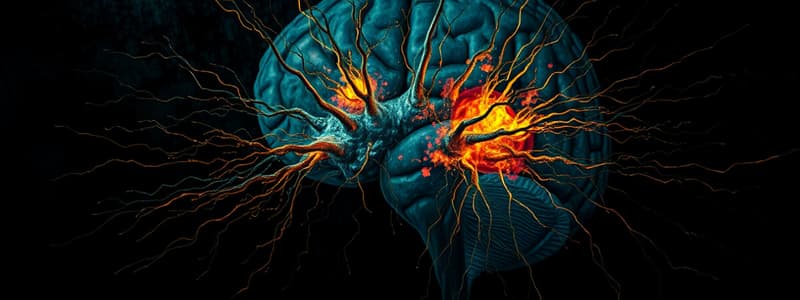Podcast
Questions and Answers
In which ipsilateral hemisphere do unilateral eye blinking seizures primarily lateralize?
In which ipsilateral hemisphere do unilateral eye blinking seizures primarily lateralize?
- Temporal lobe (correct)
- Parietal lobe
- Frontal lobe
- Occipital lobe
What is the suggested mechanism for ictal nystagmus during seizures?
What is the suggested mechanism for ictal nystagmus during seizures?
- Exhaustion of vestibular system
- Inhibition of motor cortex
- Activation of cortical saccade areas (correct)
- Activation of occipital lobes
Which area is primarily involved in ictal aphasia during seizures?
Which area is primarily involved in ictal aphasia during seizures?
- Superior temporal gyrus
- Inferior frontal gyrus (Broca's area) (correct)
- Cingulate gyrus
- Supramarginal gyrus
What is the relationship between Todd's paralysis and seizure onset?
What is the relationship between Todd's paralysis and seizure onset?
Which phenomenon defines postictal aphasia?
Which phenomenon defines postictal aphasia?
Which brain region is primarily involved in auditory auras?
Which brain region is primarily involved in auditory auras?
What is the most common aura associated with mesial temporal seizure origin?
What is the most common aura associated with mesial temporal seizure origin?
Which aura involves activation of the insula and typically does not lateralize?
Which aura involves activation of the insula and typically does not lateralize?
Which type of auras is characterized by emotional symptoms like fear and anxiety?
Which type of auras is characterized by emotional symptoms like fear and anxiety?
What type of visual aura suggests activation of the geniculostriate radiation?
What type of visual aura suggests activation of the geniculostriate radiation?
Which area is primarily stimulated to produce simple visual auras?
Which area is primarily stimulated to produce simple visual auras?
Which type of hallucination is indicative of temporo-occipital junction activation?
Which type of hallucination is indicative of temporo-occipital junction activation?
Which type of aura is often confused with olfactory auras due to overlapping symptoms?
Which type of aura is often confused with olfactory auras due to overlapping symptoms?
Which region is associated with the lateralization of seizure focus through homonymous hemifield defects?
Which region is associated with the lateralization of seizure focus through homonymous hemifield defects?
Activation of which brain structure is most characteristic of emotional auras like fear?
Activation of which brain structure is most characteristic of emotional auras like fear?
What is the primary role of ictal semiology in relation to ressective epilepsy surgery?
What is the primary role of ictal semiology in relation to ressective epilepsy surgery?
Which area of the brain is primarily involved in eliciting clear somatotopic distribution during somatosensory auras?
Which area of the brain is primarily involved in eliciting clear somatotopic distribution during somatosensory auras?
Painful auras are most commonly associated with which symptomatogenic zone?
Painful auras are most commonly associated with which symptomatogenic zone?
What is a characteristic of auditory auras involving simple sounds?
What is a characteristic of auditory auras involving simple sounds?
In patients with temporal lobe epilepsy, what can cause ipsilateral sensations during painful auras?
In patients with temporal lobe epilepsy, what can cause ipsilateral sensations during painful auras?
How can poorly defined paresthesias manifest during somatosensory auras?
How can poorly defined paresthesias manifest during somatosensory auras?
What is a common misconception regarding somatosensory auras?
What is a common misconception regarding somatosensory auras?
Which of the following statements about ictal discharges and the epileptogenic zone is true?
Which of the following statements about ictal discharges and the epileptogenic zone is true?
What is the likely consequence of late ipsiversion at the end of a generalized tonic-clonic seizure?
What is the likely consequence of late ipsiversion at the end of a generalized tonic-clonic seizure?
What is the primary cause of unilateral clonic activity during a seizure?
What is the primary cause of unilateral clonic activity during a seizure?
What does the presence of last clonic activity ipsilateral to seizure onset indicate?
What does the presence of last clonic activity ipsilateral to seizure onset indicate?
What is the expected lateralization of unilateral dystonic posturing in temporal lobe epilepsy?
What is the expected lateralization of unilateral dystonic posturing in temporal lobe epilepsy?
During a tonic phase of a GTC seizure, what does the 'figure-of-4-sign' suggest?
During a tonic phase of a GTC seizure, what does the 'figure-of-4-sign' suggest?
What is the most common lateralization observed in ictal spitting?
What is the most common lateralization observed in ictal spitting?
What describes the expected lateralization of ictal vomiting?
What describes the expected lateralization of ictal vomiting?
What mechanism might explain unilateral ictal akinesia?
What mechanism might explain unilateral ictal akinesia?
In the context of unilateral clonic activity, which Broadman area is primarily involved?
In the context of unilateral clonic activity, which Broadman area is primarily involved?
What is a significant feature of late ipsiversion observed at the end of the GTC seizure?
What is a significant feature of late ipsiversion observed at the end of the GTC seizure?
Which brain areas are commonly activated during déjà vu sensations?
Which brain areas are commonly activated during déjà vu sensations?
What is true about the occurrence of true vertigo in mesial temporal epilepsy?
What is true about the occurrence of true vertigo in mesial temporal epilepsy?
What does 'ictal urge to urinate' usually signify?
What does 'ictal urge to urinate' usually signify?
Which symptomatogenic zone is typically involved in genital sensations and orgasmic auras?
Which symptomatogenic zone is typically involved in genital sensations and orgasmic auras?
What is the characteristic of head and eye deviation during a seizure?
What is the characteristic of head and eye deviation during a seizure?
Which of the following auras is specifically linked to cardiorespiratory sensations?
Which of the following auras is specifically linked to cardiorespiratory sensations?
What percentage of patients undergoing vEEG monitoring studies experience ictal piloerection?
What percentage of patients undergoing vEEG monitoring studies experience ictal piloerection?
What is the primary area associated with the sensation of rotation or movement in auras?
What is the primary area associated with the sensation of rotation or movement in auras?
What is a common misconception about the activation of the insula in autonomic auras?
What is a common misconception about the activation of the insula in autonomic auras?
Which area is largely involved in sustained unnatural positioning during seizures?
Which area is largely involved in sustained unnatural positioning during seizures?
Flashcards
Ictal Discharge Origin
Ictal Discharge Origin
Ictal discharges start in the epileptogenic zone, causing symptoms in the symptomatogenic zone.
Epileptogenic Zone
Epileptogenic Zone
The brain area where seizures begin.
Symptomatogenic Zone
Symptomatogenic Zone
Brain region where seizure symptoms manifest.
Resective Epilepsy Surgery
Resective Epilepsy Surgery
Signup and view all the flashcards
Lateralizing Auras
Lateralizing Auras
Signup and view all the flashcards
Somatosensory Aura (SA)
Somatosensory Aura (SA)
Signup and view all the flashcards
Somatosensory Cortex
Somatosensory Cortex
Signup and view all the flashcards
Supplementary Sensorimotor Area (SMA)
Supplementary Sensorimotor Area (SMA)
Signup and view all the flashcards
Painful Aura
Painful Aura
Signup and view all the flashcards
Auditory Aura
Auditory Aura
Signup and view all the flashcards
Heschl's Gyrus
Heschl's Gyrus
Signup and view all the flashcards
Olfactory Aura
Olfactory Aura
Signup and view all the flashcards
Gustatory Aura
Gustatory Aura
Signup and view all the flashcards
Visual Aura
Visual Aura
Signup and view all the flashcards
Occipital Seizures
Occipital Seizures
Signup and view all the flashcards
Head and Eye Deviation
Head and Eye Deviation
Signup and view all the flashcards
Todd's Paralysis
Todd's Paralysis
Signup and view all the flashcards
Clonic Activity
Clonic Activity
Signup and view all the flashcards
Postictal Aphasia
Postictal Aphasia
Signup and view all the flashcards
Study Notes
Introduction
- Ictal discharges originate from the epileptogenic zone and activate the symptomatogenic zone, producing clinical semiology.
- Resective epilepsy surgery requires complete resection of the epileptogenic zone for success.
- Patients with lateralizing auras show better surgical outcomes compared to those without.
- Ictal semiology reflects the involvement of the symptomatogenic zone, not necessarily the ictal onset zone.
Auras
-
Somatosensory Auras (SAs):
- Clear somatotopic distribution indicates activation of the contralateral somatosensory cortex (Brodmann areas 3, 1, 2).
- Poorly defined paresthesias may result from the supplementary sensorimotor area (SMA).
- Activation of the superior bank of the Sylvian fissure typically produces distal and bilateral sensations, usually lateralizing but not localizing.
-
Painful Auras:
- Generally contralateral to seizure onset, activated in the postcentral gyrus and parietal lobe.
- Temporal lobe epilepsy can show ipsilateral sensations due to secondary somatosensory area activation.
-
Auditory Auras:
- Simple sounds indicate Heschl gyrus involvement (Brodmann 41 and 42); complex sounds involve auditory association cortex (Brodmann areas 42 and sometimes 22).
- Unilateral ear plugging can lateralize to the contralateral temporal lobe; its auditory nature is unclear.
-
Olfactory Auras:
- Strongly localized to mesial temporal structures, typically involving the amygdala, with possible involvement of the orbitofrontal cortex.
-
Gustatory Auras:
- Involve activation of the parietal operculum and mesiobasal temporal lobe; challenging to differentiate from olfactory auras.
-
Visual Auras:
- Simple visual auras suggest occipital seizures (Brodmann 17, 18, 19); static auras usually come from area 17 (V1).
- Homonymous hemifield defects localize the seizure focus to the contralateral hemisphere.
-
Abdominal Auras:
- Common in mesial temporal seizures; symptomatogenic zone typically in the insula.
-
Psychic Auras:
- Include emotional symptoms and familiarity distortions; fear indicates amygdala activation.
- Déjà vu sensations usually involve the uncus or entorhinal cortex, while out-of-body experiences involve the temporo-parietal junction.
-
Autonomic Auras:
- Include cardiorespiratory, GI, and cutaneous sensations, activated by various cortical areas, especially the insula.
- Ictal urge to urinate indicates non-dominant hemisphere involvement.
Lateralizing Ictal Signs
-
Head and Eye Deviation:
- Mostly contralateral to seizure onset; caused by activation of frontal eye fields and adjacent motor areas.
-
Unilateral Clonic Activity:
- Typically contralateral to seizure focus; linked to primary motor area activation.
-
Last Clonic Activity:
- In temporal lobe epilepsy, clonic jerks occur ipsilateral to seizure onset over 80% of the time, likely due to metabolic exhaustion.
-
Unilateral Dystonic Posturing:
- Reliable lateralizing sign in temporal lobe epilepsy, with high contralateral correlation.
-
Asymmetric Tonic Posturing:
- Characterized by one arm extended and the opposite flexed; extended arm is typically contralateral to seizure onset.
-
Ictal Speech:
- Preservation during seizures often lateralizes to the non-dominant hemisphere.
-
Ictal Nystagmus:
- Often related to seizures from the posterior regions; EEG changes usually contralateral to the fast phase.
Lateralizing Post-Ictal Signs
-
Todd’s Paralysis:
- Contralateral to seizure onset, likely due to exhaustion of primary motor areas.
-
Postictal Aphasia:
- Indicates involvement of language-dominant hemisphere, differentiated from postictal confusion.
-
Postictal Nosewiping:
- Common in temporal lobe epilepsy, occurring ipsilateral to the seizure onset in 75-90% of cases; exact mechanism remains unclear.
Studying That Suits You
Use AI to generate personalized quizzes and flashcards to suit your learning preferences.





